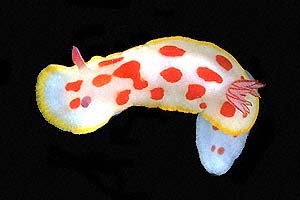
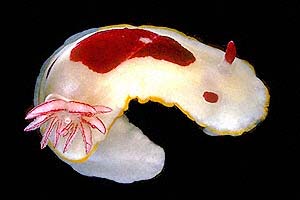
Chromodoris splendida
(Angas, 1864)
Order: NUDIBRANCHIA
Suborder: DORIDINA
Family: Chromodorididae
DISTRIBUTION
Found only in New South Wales and southern Queensland.
PHOTO
UPPER: Typical colour form from Watsons Bay, Sydney Harbour, NSW, 10m, 32mm long, September 1981.
LOWER: Northern colour form from Solitary Islands, northern New South Wales, 49mm long, March 1988.
PHOTOS: Bill Rudman.
This large white chromdorid with a thin yellow border and bright red spots is an easily recognisable chromodorid in New South Wales waters. It has red rhinophore clubs and white gills, quadrangular in cross section, are lines with red. In northern New South Wales the normal colour form, with many red spots is often replaced by specimens with a few large spots, and often a single large central spot. Compare this colour form with the spotted colour form of Chromodoris fidelis which has a sympatric distribution. There are many red-spotted species of chromodorid in New South Wales and southeastern Australia. I have discussed this example of mimicry on a separate page.
References:
•Rudman, W.B. (1983a) The Chromodorididae (Opisthobranchia: Mollusca) of the Indo-West Pacific: Chromodoris splendida, C. aspersa and Hypselodoris placida colour groups. Zoological Journal of the Linnean Society 78: 105-173.
• Rudman, W.B. (1991) Purpose in Pattern: the evolution of colour in chromodorid nudibranchs. Journal of Molluscan Studies, 57, (T.E. Thompson Memorial Issue): 5-21.
Rudman, W.B., 1998 (April 22) Chromodoris splendida (Angas, 1864). [In] Sea Slug Forum. Australian Museum, Sydney. Available from http://www.seaslugforum.net/find/chrosple
Related messages
Re: Chromodoris splendida laying eggs
February 4, 2008
From: Leanne & David Atkinson
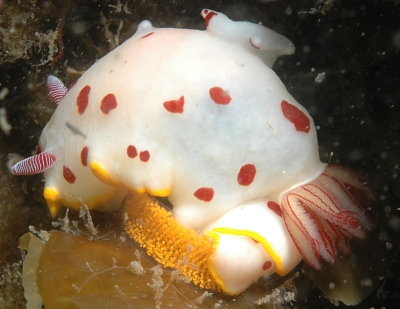
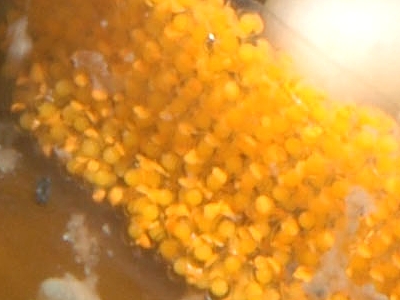
Concerning message #9319:
Dear Bill,
We found this Chromodoris splendida laying eggs on a piece of seagrass. This series of photos show the increase in size of the egg ring as it is laid, the way the nudibranch shapes the ring with its mouth and tail. We also managed a shot of the eggs coming out of the oviduct. We realise we have already sent in a photo of this species laying but thought you might be interested in this series since it shows the process more thoroughly.
Locality: Halifax Sponge Gardens, Port Stephens - Great Lakes Marine Park, Port Stephens, 5metres, New South Wales, Australia, Pacific, 30 December 2007, Rocky sandy bottom with scattered seagrass, sponges, ascidians, bryozoans and kelp.. Length: Approximately 50 mm. Photographer: Leanne & David Atkinson.
Best wishes,
Leanne & David Atkinson
atk@hunterlink.net.au
Atkinson, L. & D., 2008 (Feb 4) Re: Chromodoris splendida laying eggs. [Message in] Sea Slug Forum. Australian Museum, Sydney. Available from http://www.seaslugforum.net/find/21334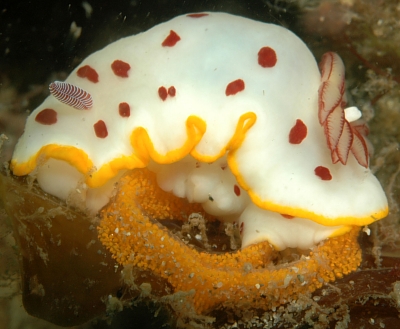
Dear Leanne & David,
It's strange how little we know of some of the more common species. Looking carefully at your photo of the egg mass we can see that there appears to be a disc-like cap of extra-capsular yolk associated with each egg. This has not been reported for this species before.
Best wishes,
Bill Rudman
Re: Colour variation in Chromodoris splendida
November 15, 2006
From: Bruce Wilkie
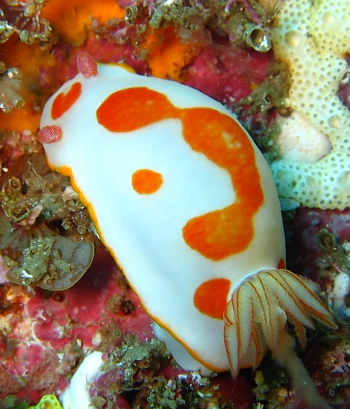
Concerning message #18280:
Hi Bill,
Here is another Chromodoris splendida to add to your collection.
This one has orange spots rather than the usual red ones.
Locality: Flat Rock North Stradbroke Island, 14 metres, Queensland Australia, Pacific ocean, 15 October 2006, rocky reef with sponges, hard & soft corals . Length: 25 mm. Photographer: Bruce Wilkie.
Many thanks,
Bruce Wilkie.
brucedwilkie@yahoo.com.au
Wilkie, B., 2006 (Nov 15) Re: Colour variation in Chromodoris splendida. [Message in] Sea Slug Forum. Australian Museum, Sydney. Available from http://www.seaslugforum.net/find/18352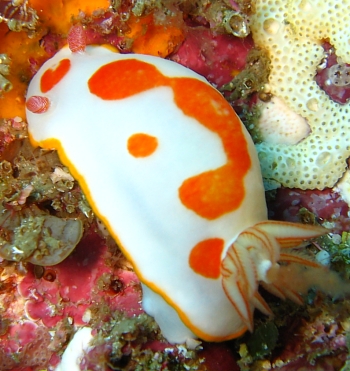
Thanks Bruce,
I can live with the orange tinge to the red spots, especially when the gills show the typical shape and colour of this species. The double red line on the outside edge of the gills and a single one on the inside edge are very characteristic of the species - however in smaller specimens this is not always clear.
Best wishes,
Bill Rudman
Re: Colour variation in Chromodoris splendida
November 14, 2006
From: Rebecca Johnson
Concerning message #18180:
Hi Bill,
Welcome back. Although, this is a huge geographic stretch and highly improbable, unless there have been confused reports, this animal reminds me of Noumea subnivalis. It looks especially like one of Nishina's photos on the N. subnivalis species page. It has the strange textured mantle, with the small, translucent spots and similar rhinophores. It is also really small, around half the size of most Chromodoris splendida on it's species page.
Any thoughts on the possibility it is a Noumea? I can't shake the idea that I have seen it before.
Thanks for entertaining my musings,
Rebecca
rjohnson@calacademy.org
Johnson, R.F., 2006 (Nov 14) Re: Colour variation in Chromodoris splendida. [Message in] Sea Slug Forum. Australian Museum, Sydney. Available from http://www.seaslugforum.net/find/18280Dear Rebecca,
Some of these groups of similarly coloured species are difficult, and the C. splendida - C. verrieri group is a good example. The reddish colour on the gills of Bruce's animal don't support the Noumea subnivalis suggestion because as far as I know that species has pure white gills. Sometimes I think we have to settle for a 'best guess'. Although dissection would be able to determine a generic placement for the specimen, anatomy alone doesn't always give us a convincing answer at the species level. - Despite that, your musings are always welcome
Best wishes,
Bill Rudman
Re: Colour variation in Chromodoris splendida
November 7, 2006
From: Nerida Wilson
Concerning message #18180:
Dear Bill and others,
Do you think this animal could be Chromodoris verrieri instead? The mantle bands are difficult to see in this photo, although laterally there seems to be only a gold band, I think there is evidence of an outer maroon one in the anterior region.
kind regards
Nerida
wilsong@auburn.edu
Wilson, N.G., 2006 (Nov 7) Re: Colour variation in Chromodoris splendida. [Message in] Sea Slug Forum. Australian Museum, Sydney. Available from http://www.seaslugforum.net/find/18208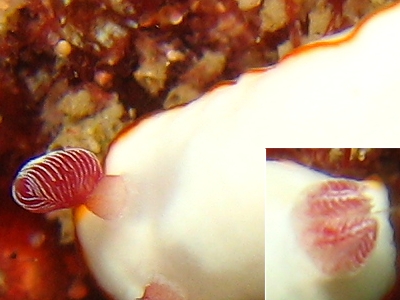
Dear Nerida,
You could indeed be right, but certainly down the side of the animal there seems no sign of a red border. In an earlier series of photos from Bruce Wilkie [see message #15876], I remark on an animal which seems to have a red as well as a yellow mantle border around the head end but not down the sides. From my experience C. verrieri has a very noticeable red outer, and yellow inner band all around the mantle edge. Then again, from my experience, C. splendida should only have a yellow band. I guess the red spots on Bruce Wilkie's earlier photo is what links this animal with red around the anterior end to C. splendida rather than C. verrieri.
Best wishes,
Bill Rudman
Re: Colour variation in Chromodoris splendida
November 3, 2006
From: Bruce Wilkie
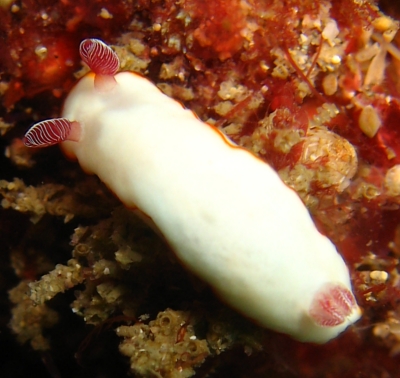
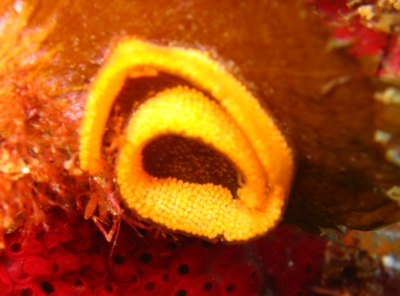
Concerning message #15876:
Hi Bill,
Some time ago you were asking for Chromodoris splendida egg ribbons. I am reasonably certain that this ribbon is from C. splendida. I also found this animal recently which I think is C. splendida without spots. Could you please confirm?
Photo - Egg ribbon: 30th September 2006, Manta Bommie, Point Lookout, North Stradbroke Island. Depth 7 m. Temp 21 deg c.
Photo - animal: Shag Rock, Point Lookout, North Stradbroke Island., 12 metres, Queensland Australia, Pacific ocean, 23 September 2006, rocky reef with sponges, hard & soft corals . Length: 15 mm. Photographer: Bruce Wilkie.
Many Thanks,
Bruce Wilkie.
brucedwilkie@yahoo.com.au
Wilkie, B., 2006 (Nov 3) Re: Colour variation in Chromodoris splendida. [Message in] Sea Slug Forum. Australian Museum, Sydney. Available from http://www.seaslugforum.net/find/18180
Dear Bruce,
When I first saw the photos I thought that that the egg ribbon was evidence that this spotless animal was C. splendida but on reading your message I see the eggs and animal were independent of each other. Certainly the egg ribbon - with large yellow eggs - looks very like the typical C. splendida egg ribbon [see message #9319]. I am also pretty sure the spotless animal is C. splendida but I have not checked its anatomy or seen it mating or associating with spotted C. splendida so I am not 100% sure. From my records, this spotless form occurs as far north as Heron Is at the southern end of the Great Barrier Reef.
Best wishes,
Bill Rudman
Chromodoris splendida from sthn Queensland
May 18, 2006
From: Ian Banks
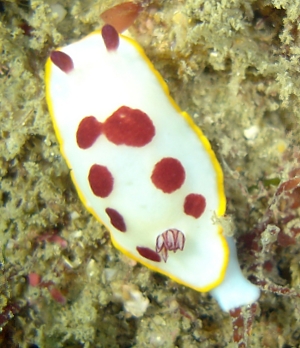
Bill,
Another variation of Chromodoris splendida for your list. It was found on Palm Beach Reef. This rocky reef has hard and soft coral, sponges, ascidians and algae. Does Chromodoris splendida only feed on sponges?
Locality: Palm Beach Reef, Gold Coast, 10 metres, Queensland, Australia, Pacific Ocean, 8 September 2005, Rocky Reef. Length: 3cm. Photographer: Ian Banks.
Regards
Ian
ianbanks@bigpond.com
Banks I.W., 2006 (May 18) Chromodoris splendida from sthn Queensland. [Message in] Sea Slug Forum. Australian Museum, Sydney. Available from http://www.seaslugforum.net/find/16638Dear Ian,
All nudibranchs are specialised feeders, and chromodorids are no exception. They are all sponge feeders, and each species has one or a few sponge species on which it exclusively feeds. C. splendida feeds on a few pink, orange and yellow species of Dictyodendrilla and Darwinella.
Best wishes,
Bill Rudman
Chromodoris splendida mating
April 27, 2006
From: Leanne & David Atkinson
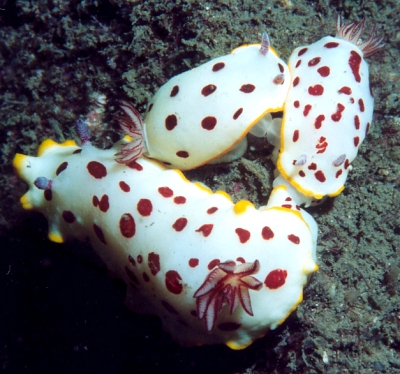
Dear Bill,
We noticed you didn't have a shot of Chromodoris splendida mating. We thought you might like to add this one to the forum.
Locality: Marina Breakwall, Nelson Bay, Port Stephens, NSW Australia. Depth: 8 m. Length: 60 mm. 19 January 2004. Manmade large rock boulder wall with some sponge and ascidian growth. Photographer: Leanne & David Atkinson
Regards,
Leanne & David Atkinson
atk@hunterlink.net.au
Atkinson, L.& D., 2006 (Apr 27) Chromodoris splendida mating. [Message in] Sea Slug Forum. Australian Museum, Sydney. Available from http://www.seaslugforum.net/find/14924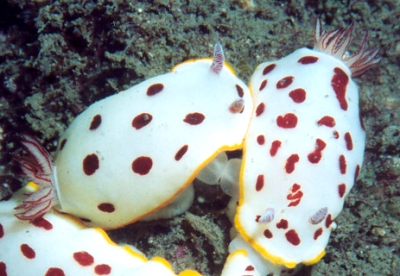
Thanks Leanne & David,
Best wishes,
Bill Rudman
Chromodoris splendida from Port Stephens
February 23, 2006
From: Leanne & David
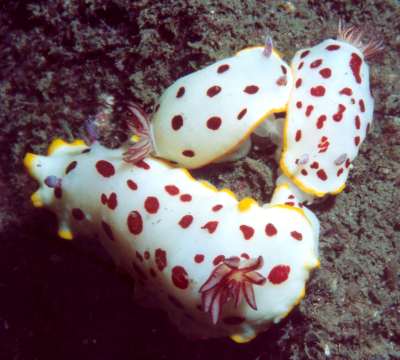
Dear Bill,
After reading Bruce Wilkie's message about Chromodoris splendida [#15827] we read the other postings on this nudibranch and there wasn't one showing the New South Wales colour version mating so we thought you might like this one. Chromodoris splendida is a very common nudibranch in the Port Stephens area over the summer months.
Locality: d'Albora Marina wall Nelson Bay, Port Stephens, 8 m, New South Wales, Australia, Pacific, 19 January 2004, Rocky breakwall covered in silt with some sponge and ascidian growth. Length: 80 to 120mm. Photographer: Leanne & David Atkinson.
Regards,
Leanne & David Atkinson
atk@hunterlink.net.au
Atkinson, L. & D., 2006 (Feb 23) Chromodoris splendida from Port Stephens. [Message in] Sea Slug Forum. Australian Museum, Sydney. Available from http://www.seaslugforum.net/find/15880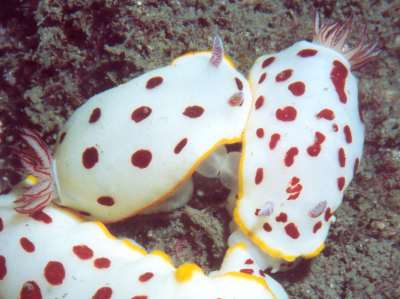
Dear Leanne & David,
Thanks for these 'typical' examples. They are a nice contrast to Bruce Wilkie's northern animals [#15876, #15877]. Interestingly, one of your animals - the largest one - also has a yellow border to the posterior part of the foot, like one of Bruce's.
Best wishes,
Bill Rudman
Colour variation in Chromodoris splendida [1]
February 23, 2006
From: Bruce Wilkie
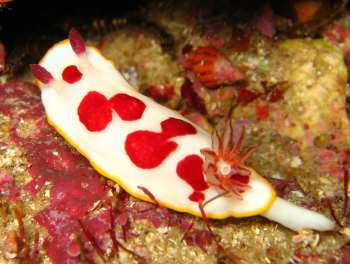
Concerning message #15827:
Hi Bill,
Here are some more Chromodoris splendida colour pattens.
Sorry I don't have egg laying photos, but I will try to get some for you. I have photos of egg spirals but can not be certain they are from C. splendida.
Locality: Flat Rock North Stradbroke Island, 10-14 metres, Queensland Australia, Pacific ocean, 20 November 2005, rocky reef with sponges, hard & soft corals . Photographer: Bruce Wilkie.
Many Thanks,
Bruce Wilkie.
brucedwilkie@yahoo.com.au
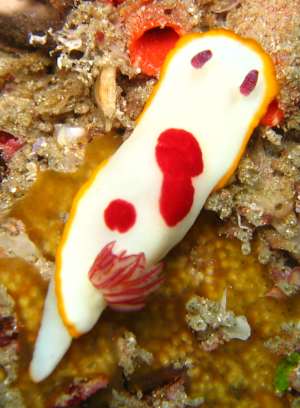
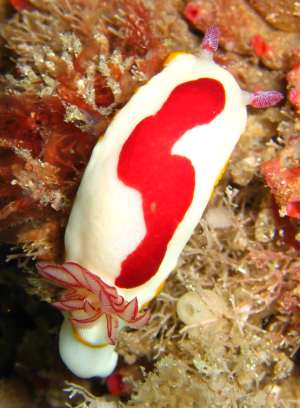
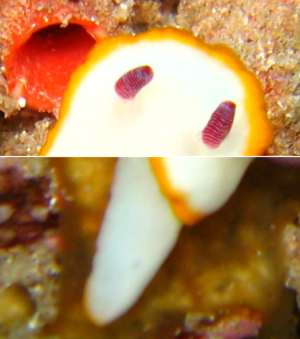
Dear Bruce,
Thanks for these and your following message [#15877]. They certainly give us a better idea of this northern population of C. splendida. One of your specimens is particularly interesting because it shows a reddish outer margin to the mantle border, not normally found in this species. It also has a yellow border to at least the tip of the foot, which is unusual, but sometimes present in typical specimens. It will be interesting.to see what the egg ribbon looks like from up your way. The Atkinson's have a good photo of a typical egg ribbon in an earlier message [#9319]
Best wishes,
Bill Rudman
Colour variation in Chromodoris splendida [2]
February 23, 2006
From: Bruce Wilkie
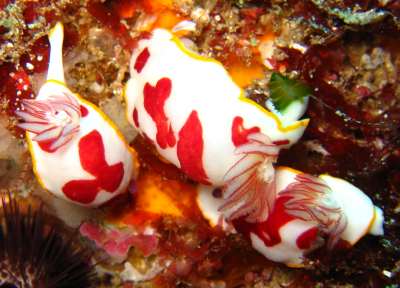
Concerning message #15827:
Hi Bill,
To accompany my earlier message [#15876] Here are some more C. splendida colour pattens.
Locality: Manta Bommie Point Lookout North Stradbroke Island, 10-14 metres, Queensland Australia, Pacific ocean, 15 november 2005, rocky reef with sponges, hard & soft corals . Photographer: Bruce Wilkie.
Many Thanks,
Bruce Wilkie.
brucedwilkie@yahoo.com.au
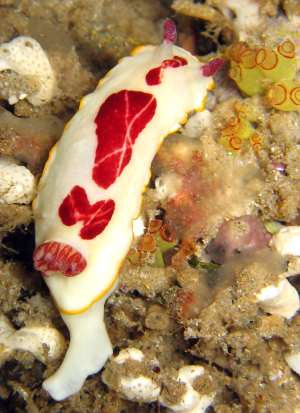
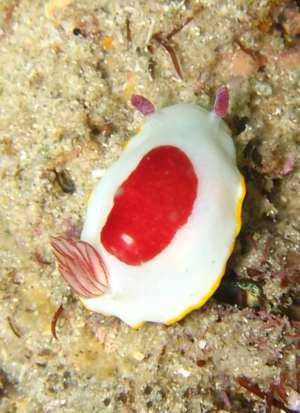
Dear Bruce,
This pattern with a single large red patch, or a few large patches, is more like the colour pattern in northern New South Wales The many spotted forms in your first message are more typical of southern populations of the species, but I guess without some idea of our common each colour pattern is its hard to say much about the similarities and differences. It's all very interesting.
Best wishes,
Bill Rudman
Re: Chromodoris splendida feeding
February 16, 2006
From: Bruce Wilkie
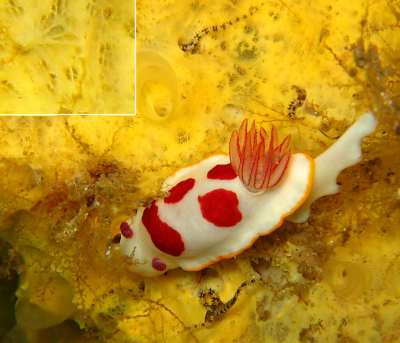
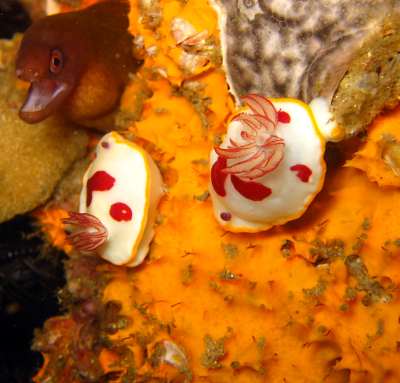
Concerning message #12033:
Hi Bill,
I have been reading Leanne & David Atkinson's posts Dec 22 2003 & Jan 29 2004 on Chromodoris splendida feeding. These animals are very common in this area and I have many photos them.
Upper photo: Single feeding on yellow sponge. December 13 2005. Shag rock. Depth 12 mtrs. Temp 22° C. Length approx 35 mm.
Middle photo: 2 feeding on orange sponge with moray eel. December 28 2005. Manta Bommie. Depth 12 mtrs. Temp 23° C. Length approx 30 mm.
Lower photo: 2 feeding on yellow sponge. December 1 2005. Flat rock. Depth 14 mtrs. Temp 22° C. Length approx 30 mm.[All Manta Bommie, Point Lookout, North Stradbroke Island, Queensland, Australia. Photographer: Bruce Wilkie]
On the lower animal you can see what I think could be part of its mouth?
I hope these are helpful to you.
Many Thanks
Bruce Wilkie.
brucedwilkie@yahoo.com.au
Wilkie, B., 2006 (Feb 16) Re: Chromodoris splendida feeding. [Message in] Sea Slug Forum. Australian Museum, Sydney. Available from http://www.seaslugforum.net/find/15827
Dear Bruce,
I think we can be pretty sure these animals are feeding on these orange and yellow sponges, which I suspect are species of Darwinella. I am interested to hear you say this is a common species at North Stradbroke Island. I would be interested in photos showing a range of the colour variation found in the species in your part of the world. In most of New South Wales it has large red spots scattered all over the mantle but in nthn New South Wales it usually has one large spot or a few large spots in the centre of the back. Some of yours seem to have the spots arranged centrally, but it would be nice to know if there is any 'common' pattern in Queensland. I would also be interested in any photos of egg-laying.
The Moray Eel in your second photo is interesting. It seems to suggest that C. splendida is not on its menu.Best wishes,
Bill Rudman
Chromodoris splendida from Jervis Bay, NSW
October 4, 2005
From: Paul Osmond
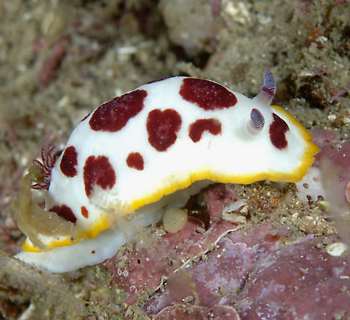
Found this single specimen of Chromodoris splendida at the 'Boat Harbour' dive site in Jervis Bay, NSW, Austrlaia. It was on a rocky reef head under a ledge.
Locality: Jervis Bay, New South Wales, Australia. Depth: 15 m. Length: 30 mm. 20 August 2005. Rocky coral reef. Photographer: Paul Osmond
Yours,
Paul
marriard@deepseaimages.com
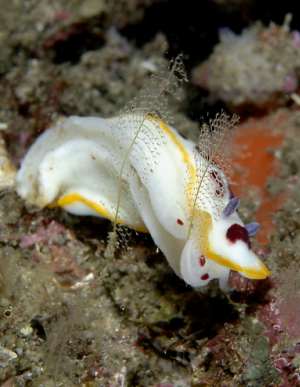
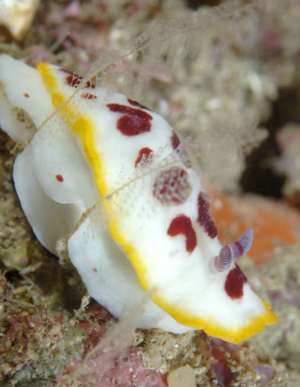
Thanks Paul,
Bill Rudman
Chromodoris splendida feeding
January 29, 2004
From: Leanne & David Atkinson
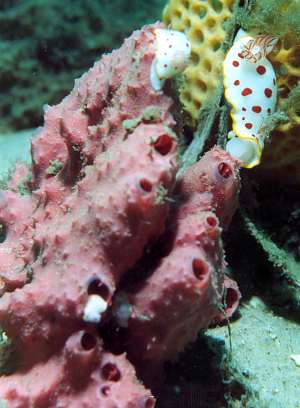
Dear Bill,
You said you wanted photos of Chromodorids feeding on sponges. Here are some photos of Chromodoris splendida feeding on a pink sponge. You can see the mouth parts quite clearly. All three photos attached were of the same individual and sponge. There were 4 or 5 Chromodoris splendida on the same sponge.
Location: Fly Point, Marine Reserve, Port Stephens, NSW Australia
Date: 8 November 2003 Time: 9:00am
Tide: high tide
Regards
Leanne & David Atkinson
atk@hunterlink.net.au
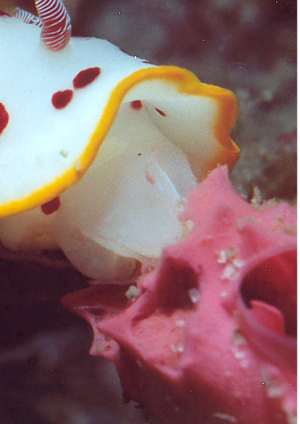
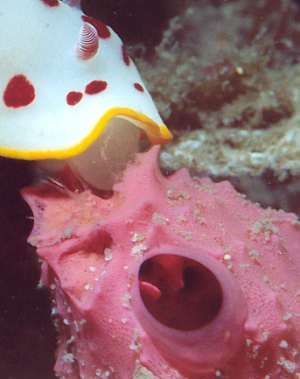
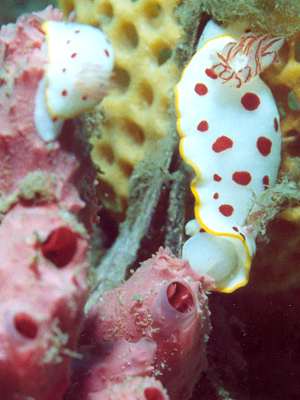
Dear Leanne & David,
Thanks for these photos. There is clearly no doubt that they are feeding. This sponge is Darwinella gardineri, a common southeastern Australian sponge which I thought, until your recent message, was the only sponge this species ate.
Best wishes
Bill Rudman
Chromodoris splendida feeding
December 22, 2003
From: David & Leanne Atkinson
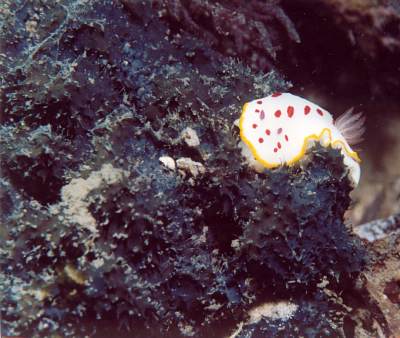
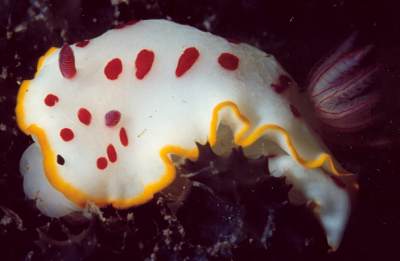
Dear Bill,
Is this Chromodoris splendida feeding? There wasn't a record of it eating this Black/Charcoal coloured sponge on the forum. The mouth parts definitely seemed everted. We found it at the weekend details as follows:
Date: 14 December 2003
Locality: Fly Point Marine Reserve, Port Stephens, NSW, Australia
Depth: 8m Water Temperature: 19degrees c.
Tide: 12:30pm 1.6m
Thanks for your help.
Merry Christmas,
Leanne & David Atkinson
atk@hunterlink.net.au
Atkinson, D. & L., 2003 (Dec 22) Chromodoris splendida feeding. [Message in] Sea Slug Forum. Australian Museum, Sydney. Available from http://www.seaslugforum.net/find/11709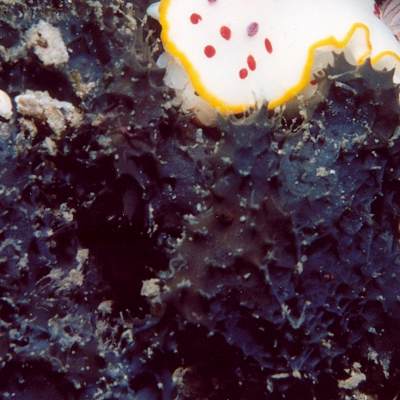
Dear David & Leanne,
Thanks for this record. It is indeed a new feeding record for the species. I have a sponge expert visiting in January and one of our aims is to identify as many of the sponges on the Forum as we can so rather than confusing the issue by giving you a tentative name now, I'll wait until I have a confident identification
Best wishes
Bill Rudman
Chromodoris splendida laying eggs
March 11, 2003
From: Leanne & David Atkinson
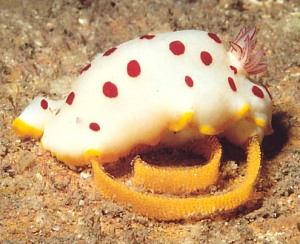
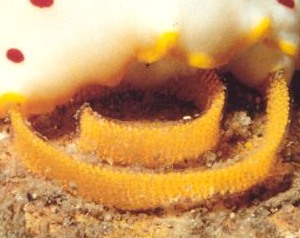
Dear Bill,
I noticed you didn't have a photo of Chromodoris splendida laying eggs so we thought we'd send this one in to add to the collection.
Location: Fly Point, Marine Reserve
Port Stephens, NSW, Australia
Date: 31st December 2000
Time: 12:30pm
Tide: High tide 1.5m
Depth: 10m
Cheers,
Leanne & David Atkinson
atk@hunterlink.net.au
Atkinson, L & D., 2003 (Mar 11) Chromodoris splendida laying eggs. [Message in] Sea Slug Forum. Australian Museum, Sydney. Available from http://www.seaslugforum.net/find/9319Dear Leanne & David,
Thanks for this. It is often the most common ones we know least about. We just assume it must be reported somewhere. I suspect from the relatively large size of the eggs that this species as lecithotrophic larvae - that is larvae that spend a short non-feeding period in the plankton. Compare this photo with your photo of the egg ribbon of Ceratosoma amoena which has much smaller eggs and planktotrophic larvae which spend some time in the plankton feeding on phytoplankton.
Best wishes
Bill Rudman
Chromodoris splendida feeding
March 9, 2002
From: David Wachenfeld
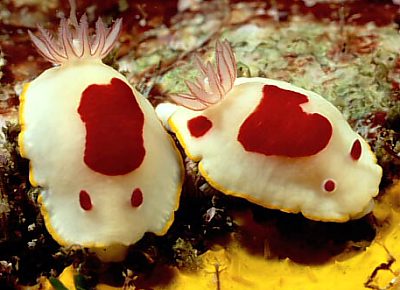
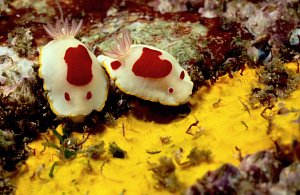
Hello Bill
Here is a photo I took at Julian Rocks, Byron Bay, nthn New South Wales, Australia in December 2001. I would be very grateful for any help with species id or behavioural information. Many thanks.
Regards,
David
triggerfish@bigpond.com
Wachenfeld. D., 2002 (Mar 9) Chromodoris splendida feeding. [Message in] Sea Slug Forum. Australian Museum, Sydney. Available from http://www.seaslugforum.net/find/6347Dear David,
This is great photo of an interesting animal. This is the 'one-spot' form of Chromodoris splendida. In southern and central New South Wales this species has many red spots on the mantle presumably to match the prevailing red-spotted colour pattern in that region [see red-spot mimicry page]. In northern New South Wales however this single red spot form prevails. This species is endemic to New South Wales and southern Queensland. It feeds on at least two species of aplysillid sponge (Darwinella spp), one pink, one yellow. If you look carefully at the UPPER photo you can see a white 'bump' at the front of each animal. This is the 'oral tube' a sort of proboscis which is everted when the animal is feeding so the buccal bulb and their radular teeth can scrape and bite off pieces of the sponge. It's not often you can get a photo at this angle to show them feeding. I have sometimes suggested that one way to check if a sponge feeder is actually feeding is to gently lift it off its sponge and see if the buccal bulb is everted. This is the white 'thing' you should look for.
Best wishes,
Bill Rudman
Chromodoris splendida
July 20, 1999
From: Neil Miller
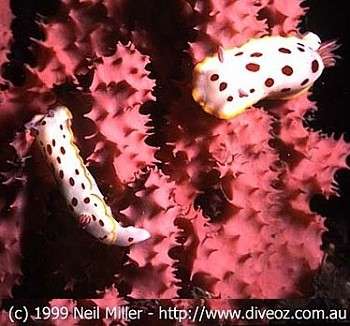
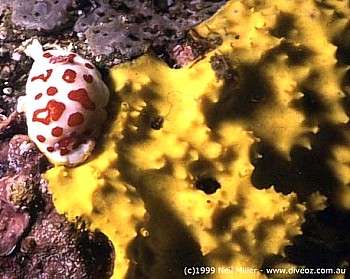
Hi Bill,
Thanks for the identification of my last photo. Here are the two photos of Chromodoris splendida from my website for Scuba Divers at http://www.diveoz.com.au . I'm sorry I can't give you any collection details, but will keep information in future. I don't 'pose' animals for photos so they really were on these sponges.
Neil Miller
webguy@diveoz.com.au
Miller, N., 1999 (Jul 20) Chromodoris splendida. [Message in] Sea Slug Forum. Australian Museum, Sydney. Available from http://www.seaslugforum.net/find/1085Dear Neil,
The photos are interesting because they show Chromodoris splendida on two different species of sponge. The pink one is probably Darwinella cf. gardineri and the yellow one Darwinella cf. oxeata [Aplysillidae, Dendroceratida].
We are gradually building up information on the natural history of these animals and photos like this from divers is a great way to do it. It is true that not all possible food items that nudibranchs are found on are in fact their food, but if we have many photos of one nudibranch usually associating with one or two sponges or hydroids or ascidians then we can be pretty sure there is a biological relationship which is worth exploring.
Best wishes,
Bill Rudman.
Understanding Chromodoris splendida
May 22, 1998
From: Wayne Ellis
Hi Bill,
Thanks for the ID's.
I need to clarify my understanding of C. splendida. Your June 1983 (ZJLS V. 78) paper describes this species with a band of gold right at the edge. Inside the gold edge there are large red patches usually ovoid or circular in outline. The species I sent the pic of has an orange spot, orange border on the mantle, orange gills & rhinophores. I have, since you first gave me copies of your paper tried to be very careful about spotting the differences in the C. splendida group.
Would a specimen or better pics help? This beast to me has no colour similarity to C. splendida.
Bill, I wish to make very clear, I'm not having a go at you. Your identification has made me question my observation skills.
Regards
Wayne
glaskin@ozemail.com.au
Ellis, W., 1998 (May 22) Understanding Chromodoris splendida. [Message in] Sea Slug Forum. Australian Museum, Sydney. Available from http://www.seaslugforum.net/find/160
I'm never offended at having my views questioned, so never worry about having a go at me. Here are a couple of other photos of Steve Grail's in the lot you sent me from Mooloolaba which I also think are C. splendida which with the photos already posted helps show the range of variation in the species. C. splendida in central and southern New South Wales is white with large red spots/patches, a rich yellow mantle border, red rhinophore clubs and red-lined gills. In northern New South Wales and southern Queensland strange things happen to the red spots. Often there is only one, sometimes none. In short the photo you sent me fits a pattern I know from up your way with one large red spot on the back. In your photo the colour of the red spot is a bit washed out but it is quite a different colour to the "orange" edging the border. You will note that the rhinophore clubs and the edges of the gills are the same colour as the spots.
The message I have been trying to get across is that we have to look at colour patterns and combinations of colours rather than just say red spots. In this case the redspots on the back, the lines on the gills and the red rhinophores are all the same colour even if the "red" has become a bit faded.
In a paper of mine on chromodorid colour patterns in southeastern Australia (Rudman, 1991) I illustrate how a number of species of chromodorid in southeastern Australia change their colour pattern over parts of their range. Not only do some species evolve similar colour patterns to mimic each other, but a few species mimic different species in different parts of their range and so have evolved different colour patterns in different places..... Bill Rudman
Rudman, W.B., 1998 (May 22). Comment on Understanding Chromodoris splendida by Wayne Ellis. [Message in] Sea Slug Forum. Australian Museum, Sydney. Available from http://www.seaslugforum.net/find/160Found at Mooloolaba
April 22, 1998
From: Wayne Ellis
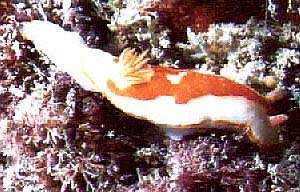
Bill,
Here is one of Steve Grail's photos for identification. He basically told me the pics were taken 10-20m, between 1996-98 off Mooloolaba.
Regards,
Wayne Ellis
glaskin@ozemail.com.au
Ellis, W., 1998 (Apr 22) Found at Mooloolaba. [Message in] Sea Slug Forum. Australian Museum, Sydney. Available from http://www.seaslugforum.net/find/49This is an interesting colour form of Chromodoris splendida. The species is only found in New South Wales and southern Queensland and through most of its range it has a pattern of many medium sized spots as in the photo above. However in northern part of its range, from about Coffs Harbour north most animals have a single large red patch or in some cases are white with no red patch or spots at all. I have also seen a photograph of animals from Heron Island and the Bunker Group at the southern end of the Great Barrier Reef which have many small red spots. It is possibly the same species but I have been unable to get any specimens to confirm this.
Chromodoris splendida is one of a group of species of chromodorid in southeastern Australia which have evolved a sinilar red spotted colour pattern. As with all chromodorids these species all have distasteful chemicals in their skins to deter predators. We think they mimic each other so that fish are more easily taught to leave red-spotted slugs alone. Go to my research pages for further information or straight to a page which shows a group of these red-spotted chromodorids... Bill Rudman
Rudman, W.B., 1998 (Apr 22). Comment on Found at Mooloolaba by Wayne Ellis. [Message in] Sea Slug Forum. Australian Museum, Sydney. Available from http://www.seaslugforum.net/find/49